Building Blocks Cheater Cloth Quilt
It’s amazing just how vast and many-legged this Building Blocks Quilt Along is becoming! Today I’m sharing a special post focused solely on the Building Blocks Cheater Cloth fabric printed by Spoonflower.
We now have 3 different colorways for this Cheater Cloth Fabric!
Click here to check out the Colorful! with White Background
Click here to check out the Colorful! with Purple Background
Click here to check out the Blue with Gray Background
I’ve received a lot of questions about the fabric, how to prepare it, how to quilt with it, and of course, how to finish your blocks at the end to make a quilt. I want to make sure you know what to do, no matter if you’re piecing and quilting or you’re just quilting the blocks, this is a super fun quilt to be working on and I want you to get started on the right foot!
The first and most important thing to understand is the Spoonflower fabric is an alternative to purchasing the Building Blocks Quilt Pattern and cutting and piecing the blocks. If you are short on time, or if you wish only to practice free motion quilting the blocks this might be a better option for you.
I’ve also gotten a lot of questions from longarm quilters who want to join in. Rather than take the time to piece all the blocks and connect them together, the Spoonflower fabric will allow you to get started on one big panel of fabric with no extra prep other than loading it onto your rail system.
So here’s the steps to using the cheater cloth fabric:
#1 – Purchase 3 yards of fabric right here. You will need 3 yards in order to get all 42 blocks of the quilt. Yes, this is a bit pricey, but it’s a good option if you don’t want to buy the pattern, fabric, and cut and piece all the blocks one by one.
No matter which colorway you go with, you will need 3 yards. Scroll back up to find links to the three colorways currently available.
As for fabric types – my favorite is the Kona cotton, but the basic combed cotton will work great too. Josh is using the basic combed cotton for his quilt blocks.
#2 – Don’t wash the fabric. This is the only time I will tell you not to prewash fabric! I just don’t think it’s necessary before you cut out the blocks. I’ve also found when working with Spoonflower that it tends to fade more when washed as yardage than as a quilt. Maybe the extra agitation? Regardless, I think it works just fine straight out of the package and also that’s more time saved not having to wash, dry, then starch and iron the fabric flat again.
#3 – Cut apart the blocks carefully leaving 1 inch all around. Using scissors or a rotary cutter, slice the blocks apart in rows, then cut the rows apart to have single blocks. These should measure around 10 inches square, give or take a bit, with an 8 inch printed square in the middle.
Note for Longarmers – Don’t cut your blocks apart! Instead load the entire 3 yard strip into your rail system with batting and backing fabric and start quilting block by block. You will have a 1 inch section of open space between the blocks you can play in as well and this is a good opportunity to play with different scales (sizes) of designs.
#4 – Baste the blocks with batting and backing. Just follow the same instructions right here for basting, and take some time to consider your batting choices. Here’s the amounts you will need:
Batting – 62″ x 72″ minimum size, cut into 10 inch squares.
Backing – 3 1/4 yards backing fabric (44 inch wide 100% cotton fabric)
– OR – 42 layer cake (10 inch) squares
#5 – Free motion quilt on all the lines. The lines are printed in black, so a bright blue thread would probably be the best choice if you want to hide thread issues as much as possible. Josh is stitching in white simply for the lines to be super visible on camera.
#6 – Cut the blocks down to 8 inches square. After you’ve completed quilting all the blocks, place a ruler on top and square the block to 8 inches. You may find the block has shrunk a bit, so don’t just automatically cut the block along the perimeter lines. Actually measure and cut an 8 inch square with the block design centered in the middle.
#7 – Cut your binding. To connect the blocks together you will need 1 3/4 yards of binding, which is broken down into the following sections and cut into strips:
Connecting Binding for Back Side – Seam together all 9 of the 1” wide width of fabric strips.
Edge Binding – Connect all 2” strips together into one long strip. Fold in half and press with a hot, dry iron to flatten.
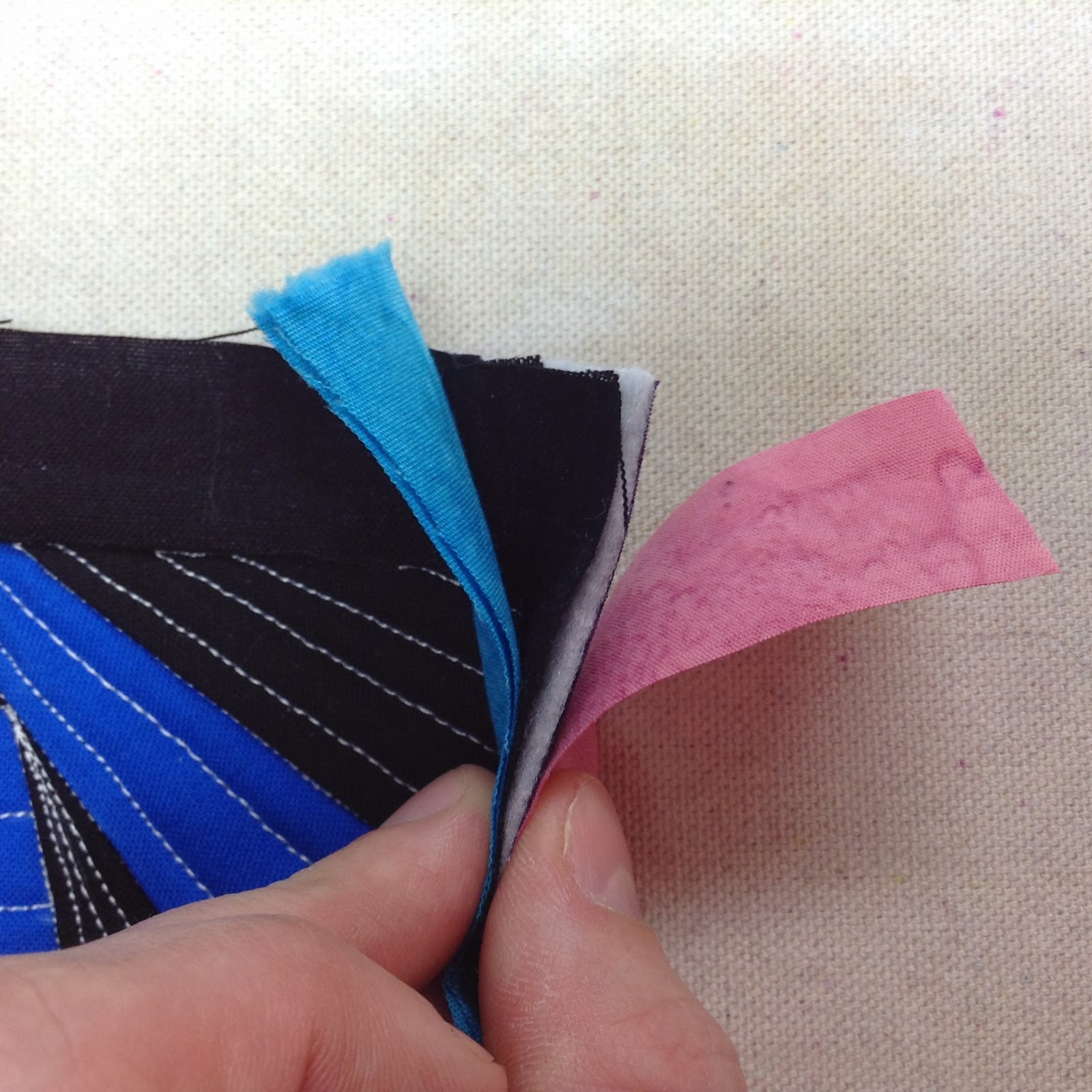 |
| Layer quilted square with folded binding on top and 1” binding on the back |
Connection Step 1 – Starting the first block you’re connecting, make the following stack along the right side of the block:
– 1.5” x 9” folded strip on top (blue)
– 8” quilted block
– 1” x 9” back binding strip on the bottom (pink)
Align all three pieces with raw edges to the right side. Stitch together with an accurate 1/4” seam allowance.
Note: You may need to use a walking foot to make all the layers feed evenly through the machine.
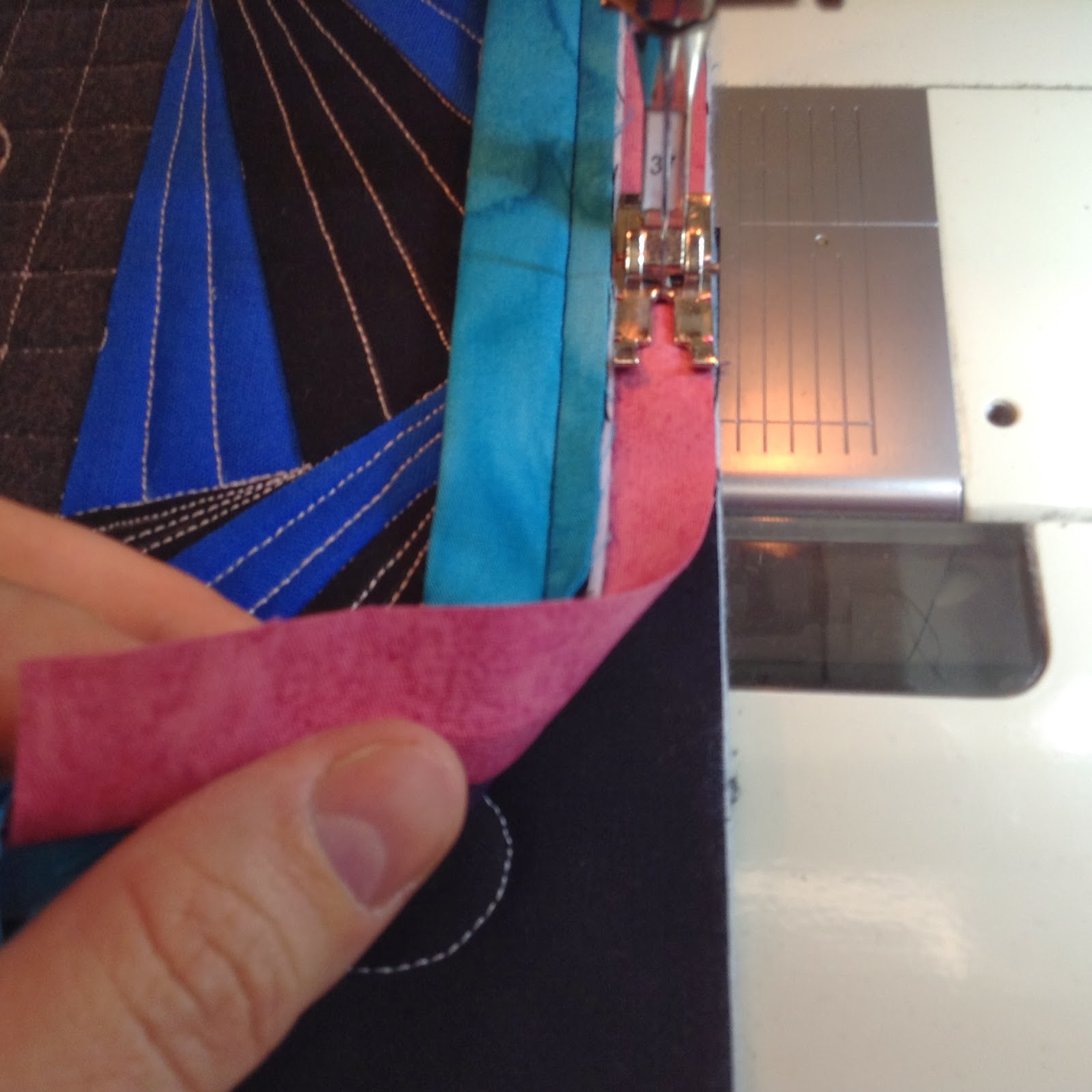 |
| Step 2 – 1” binding stitched to the back of 2nd block |
Connection Step 2 – Fold over the 1” binding on the back of the block and press. Place a second block WRONG sides together with Block #1, aligning the right side with the edge of the 1” back binding. Stitch together with an accurate 1/4” seam allowance.
Note: With this seam, you are only stitching through the 1” back binding and Block #2. Do not stitch through the folded 1.5” front binding or Block #1.
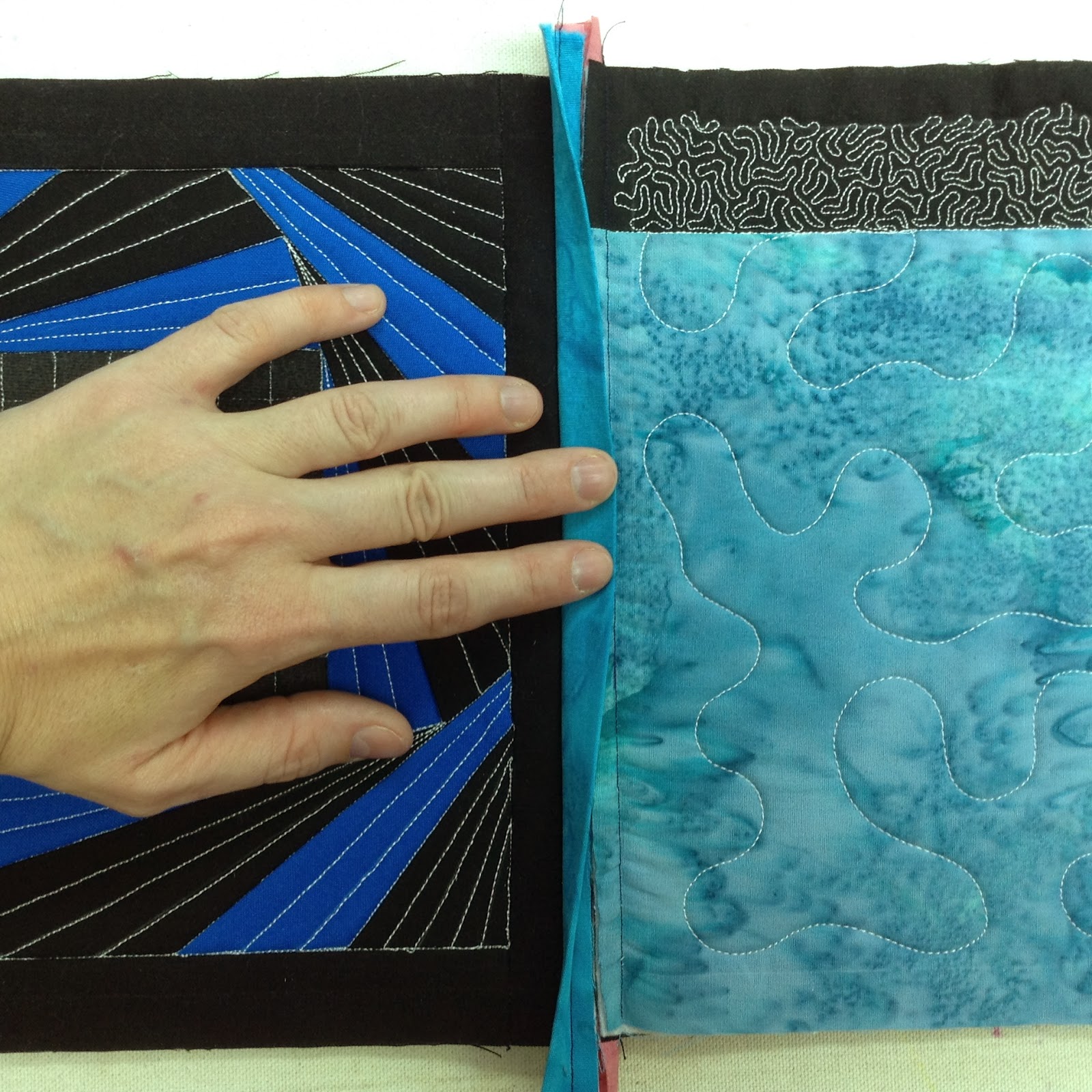 |
| Press folded edge over to encase seam allowances and zigzag to secure |
Connection Step 3 – Spread both connected blocks flat and finger press the two 1/4” seam allowances into the channel created by the back 1” binding.
Fold over the front folded binding and press to cover the seam allowances of both blocks.
Secure this folded edge to the blocks using a zigzag stitch on your ma-chine, or hand stitch it in place.
Repeat connecting the blocks together to create a row using this binding method. Repeat again, connecting the rows together with the long binding strips to connect the entire quilt together.
#9 – Bind the quilt – If you haven’t already, connect the 2” edge binding strips together, then fold in half and press with a hot, dry iron.
Apply the binding to the quilt using your favorite method. Click here find a video on the method I use for machine binding a quilt.
So that’s it! This is jumping very far ahead of where we are on the Building Blocks Quilt Along, but it should answer any remaining questions you may have about the Spoonflower Fabric and how it works. Click here to pick up your Spoonflower cheater cloth, and remember to select 3 yards in order to get all the blocks for this quilt!
Click here to check out the Colorful! with White Background
Click here to check out the Colorful! with Purple Background
Click here to check out the Blue with Gray Background
If you still have questions, please post them below and I’ll answer them and update the post so everyone is on the same page.
Let’s go quilt,
Leah Day



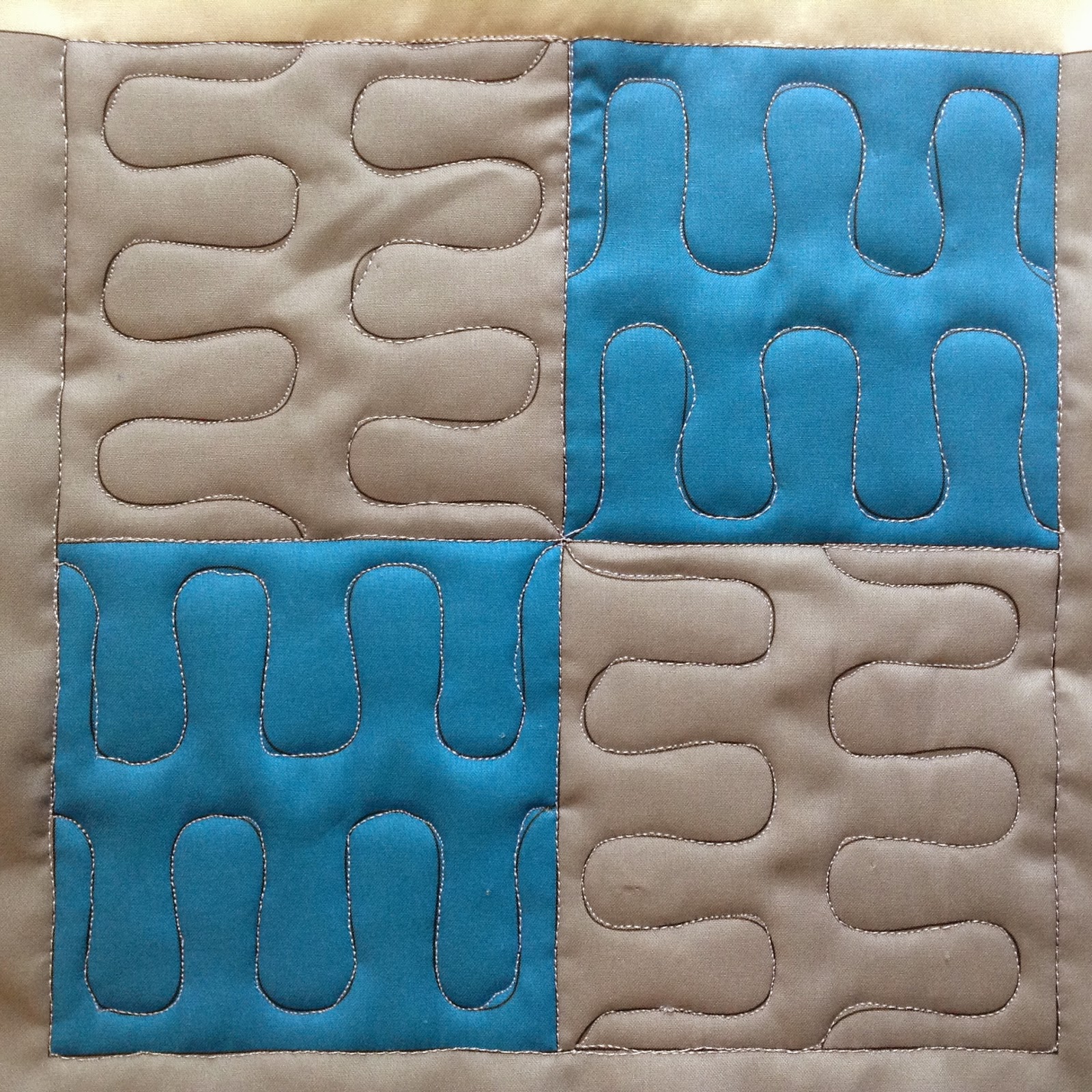
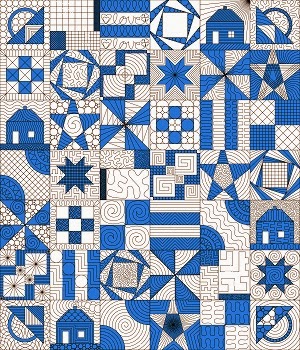
Interesting. I haven't visited for a while. Are you saying the Spoonflower cheater fabric actually has the FMQ lines printed on it? So the purpose of this quilt is to practice different FMQ designs? Great concept – am I understanding this correctly? Have a super day!
Hi Jennifer – The spoonflower cheater cloth has the quilting lines for 42 blocks printed on the fabric. The purpose is to practice quilting on the line and to get comfortable with a variety of simple designs: wiggly u shapes, circles, straight lines, etc.
This is really just another option for following along with the Building Blocks Quilt Pattern. You have a choice of piecing and quilting the blocks, or just quilting with the spoonflower fabric.
Cheers,
Leah
Hi Leah. I finally have my fabric and other supplies and I created the 3 four patch blocks. I am having trouble seeing the lines through the darker fabric! Should I punt and just use lighter fabric? I know I will want to use these techniques again and don't want to always have to use light fabric to trace designs.
Any thoughts?
Hi Sharon – A lot of quilters on the facebook group have been building lightboxes this week to sort out this very issue. Another idea would be to use tracing paper over the block, line up the quilting guide on top, then draw on all the lines with a blunt too, like a knitting needle to transfer the marks to the fabric. You might have to get a bit creative in order to transfer all the marks to all the blocks.
Cheers,
Leah Day
Hi Leah. I was able rig up a temporary light box and marked the first 3 blocks. I am going to work on getting a light box though.
Thanks for the suggestion!
Going to quilt my Wiggly U Shapes tonight. 🙂
Sharon
A good substitute for a light box is a sturdy, shallow plastic box with a sturdy lid. Inside of the box put one of the battery powered closet lights that can easily be turned on or off. No cord to deal with.
I'm wondering how prominent the quilting lines are on the fabric. My concern is that, if I miss getting exactly on the line, will it be forever on the quilt or do the lines wash out? I'd like to do this in addition to making a pieced quilt but I'd like to have two quilts when I finish. Thanks.
Hi Grandmasewnsew – The lines on the cheater cloth are 1 pixel wide, which is thin enough for you to easily stay on the line, and not so thick it looks chunky on the quilt. However, if you stitch off the line, yes, it will be noticeable. Just remember that your batting choice can make a bit difference here and a 100% cotton batting will shrink down considerably and hide a lot of little mistakes in the folds of the fabric and batting.
Hi Leah, I just received my Colorful Cheater Cloth (so cute) and was wondering if you recommend matching my Isacord thread color to the color of the different lines (ie, white to white, yellow to yellow,etc). I would like for the line not to show through if possible. Thanks!
I would highly recommend contrasting thread with the lines so you can clearly see where you've stitched and where you have left to work. A hot pink or bright blue thread would look great with the colors in the cheater cloth and even if your quilting isn't perfect, the point of this project is to learn and build skill. You can't do that if you're quilting in the dark and unable to see your thread against the fabric.
Thanks, Leah, that is a great idea…I will try to remember not to focus so much on perfection…hard for me though 😉
I have been reading your site and watching videos. Learning so much!!! Have a quick question about joining the blocks together. What if you wanted the strips between the blocks to be 2 inches or more? I'm thinking the center of it would be hollow since the 1/4 inch seams would not fill the entire space. Do you have suggestions?
I just picked up this project again. Back when this project was new, I bought the Spoonflower colorful cloth, cut it up, and started on it. I'm sure I bought 3 yards (I follow directions pretty well), but I just realized I have none of the "Disappearing Nine-Patch" nor "Spinning Square" blocks. This isn't disastrous, as I'm planning to use the blocks separately, but it is puzzling! (Especially if [I can't remember] the blocks are mixed up on the panel, because that would mean I didn't just "not get" a couple rows.)
Hmm….are you sure you purchased 3 yards? Also did you have it printed on Kona cotton or the basic cotton? I just double checked the files and they are all previewing correctly and will print all the blocks within 3 yards of fabric.